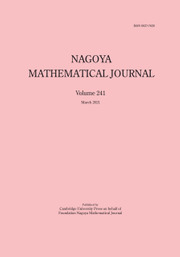Let  {\mathcal{V}} be a complete discrete valuation ring of unequal characteristic with perfect residue field,
{\mathcal{V}} be a complete discrete valuation ring of unequal characteristic with perfect residue field,  u:{\mathcal{Z}}{\hookrightarrow}\mathfrak{X} be a closed immersion of smooth, quasi-compact, separated formal schemes over
u:{\mathcal{Z}}{\hookrightarrow}\mathfrak{X} be a closed immersion of smooth, quasi-compact, separated formal schemes over  {\mathcal{V}},
{\mathcal{V}},  T be a divisor of
T be a divisor of  X such that
X such that  U:=T\cap Z is a divisor of
U:=T\cap Z is a divisor of  Z, and
Z, and  \mathfrak{D} a strict normal crossing divisor of
\mathfrak{D} a strict normal crossing divisor of  \mathfrak{X} such that
\mathfrak{X} such that  u^{-1}(\mathfrak{D}) is a strict normal crossing divisor of
u^{-1}(\mathfrak{D}) is a strict normal crossing divisor of  {\mathcal{Z}}. We pose
{\mathcal{Z}}. We pose  \mathfrak{X}^{\sharp }:=(\mathfrak{X},\mathfrak{D}),
\mathfrak{X}^{\sharp }:=(\mathfrak{X},\mathfrak{D}),  {\mathcal{Z}}^{\sharp }:=({\mathcal{Z}},u^{-1}\mathfrak{D}) and
{\mathcal{Z}}^{\sharp }:=({\mathcal{Z}},u^{-1}\mathfrak{D}) and  u^{\sharp }:{\mathcal{Z}}^{\sharp }{\hookrightarrow}\mathfrak{X}^{\sharp } the exact closed immersion of smooth logarithmic formal schemes over
u^{\sharp }:{\mathcal{Z}}^{\sharp }{\hookrightarrow}\mathfrak{X}^{\sharp } the exact closed immersion of smooth logarithmic formal schemes over  {\mathcal{V}}. In Berthelot’s theory of arithmetic
{\mathcal{V}}. In Berthelot’s theory of arithmetic  {\mathcal{D}}-modules, we work with the inductive system of sheaves of rings
{\mathcal{D}}-modules, we work with the inductive system of sheaves of rings  \widehat{{\mathcal{D}}}_{\mathfrak{X}^{\sharp }}^{(\bullet )}(T):=(\widehat{{\mathcal{D}}}_{\mathfrak{X}^{\sharp }}^{(m)}(T))_{m\in \mathbb{N}}, where
\widehat{{\mathcal{D}}}_{\mathfrak{X}^{\sharp }}^{(\bullet )}(T):=(\widehat{{\mathcal{D}}}_{\mathfrak{X}^{\sharp }}^{(m)}(T))_{m\in \mathbb{N}}, where  \widehat{{\mathcal{D}}}_{\mathfrak{X}^{\sharp }}^{(m)} is the
\widehat{{\mathcal{D}}}_{\mathfrak{X}^{\sharp }}^{(m)} is the  p-adic completion of the ring of differential operators of level
p-adic completion of the ring of differential operators of level  m over
m over  \mathfrak{X}^{\sharp } and where
\mathfrak{X}^{\sharp } and where  T means that we add overconvergent singularities along the divisor
T means that we add overconvergent singularities along the divisor  T. Moreover, Berthelot introduced the sheaf
T. Moreover, Berthelot introduced the sheaf  {\mathcal{D}}_{\mathfrak{X}^{\sharp }}^{\dagger }(\text{}^{\dagger }T)_{\mathbb{Q}}:=\underset{\underset{m}{\longrightarrow }}{\lim }\,\widehat{{\mathcal{D}}}_{\mathfrak{X}^{\sharp }}^{(m)}(T)\otimes _{\mathbb{Z}}\mathbb{Q} of differential operators over
{\mathcal{D}}_{\mathfrak{X}^{\sharp }}^{\dagger }(\text{}^{\dagger }T)_{\mathbb{Q}}:=\underset{\underset{m}{\longrightarrow }}{\lim }\,\widehat{{\mathcal{D}}}_{\mathfrak{X}^{\sharp }}^{(m)}(T)\otimes _{\mathbb{Z}}\mathbb{Q} of differential operators over  \mathfrak{X}^{\sharp } of finite level with overconvergent singularities along
\mathfrak{X}^{\sharp } of finite level with overconvergent singularities along  T. Let
T. Let  {\mathcal{E}}^{(\bullet )}\in \underset{\displaystyle \longrightarrow }{LD}\text{}_{\mathbb{Q},\text{coh}}^{\text{b}}(\widehat{{\mathcal{D}}}_{\mathfrak{X}^{\sharp }}^{(\bullet )}(T)) and
{\mathcal{E}}^{(\bullet )}\in \underset{\displaystyle \longrightarrow }{LD}\text{}_{\mathbb{Q},\text{coh}}^{\text{b}}(\widehat{{\mathcal{D}}}_{\mathfrak{X}^{\sharp }}^{(\bullet )}(T)) and  {\mathcal{E}}:=\varinjlim ~({\mathcal{E}}^{(\bullet )}) be the corresponding object of
{\mathcal{E}}:=\varinjlim ~({\mathcal{E}}^{(\bullet )}) be the corresponding object of  D_{\text{coh}}^{\text{b}}({\mathcal{D}}_{\mathfrak{X}^{\sharp }}^{\dagger }(\text{}^{\dagger }T)_{\mathbb{Q}}). In this paper, we study sufficient conditions on
D_{\text{coh}}^{\text{b}}({\mathcal{D}}_{\mathfrak{X}^{\sharp }}^{\dagger }(\text{}^{\dagger }T)_{\mathbb{Q}}). In this paper, we study sufficient conditions on  {\mathcal{E}} so that if
{\mathcal{E}} so that if  u^{\sharp !}({\mathcal{E}})\in D_{\text{coh}}^{\text{b}}({\mathcal{D}}_{{\mathcal{Z}}^{\sharp }}^{\dagger }(\text{}^{\dagger }U)_{\mathbb{Q}}) then
u^{\sharp !}({\mathcal{E}})\in D_{\text{coh}}^{\text{b}}({\mathcal{D}}_{{\mathcal{Z}}^{\sharp }}^{\dagger }(\text{}^{\dagger }U)_{\mathbb{Q}}) then  u^{\sharp (\bullet )!}({\mathcal{E}}^{(\bullet )})\in \underset{\displaystyle \longrightarrow }{LD}\text{}_{\mathbb{Q},\text{coh}}^{\text{b}}(\widehat{{\mathcal{D}}}_{{\mathcal{Z}}^{\sharp }}^{(\bullet )}(U)). For instance, we check that this is the case when
u^{\sharp (\bullet )!}({\mathcal{E}}^{(\bullet )})\in \underset{\displaystyle \longrightarrow }{LD}\text{}_{\mathbb{Q},\text{coh}}^{\text{b}}(\widehat{{\mathcal{D}}}_{{\mathcal{Z}}^{\sharp }}^{(\bullet )}(U)). For instance, we check that this is the case when  {\mathcal{E}} is a coherent
{\mathcal{E}} is a coherent  {\mathcal{D}}_{\mathfrak{X}^{\sharp }}^{\dagger }(\text{}^{\dagger }T)_{\mathbb{Q}}-module such that the cohomological spaces of
{\mathcal{D}}_{\mathfrak{X}^{\sharp }}^{\dagger }(\text{}^{\dagger }T)_{\mathbb{Q}}-module such that the cohomological spaces of  u^{\sharp !}({\mathcal{E}}) are isocrystals on
u^{\sharp !}({\mathcal{E}}) are isocrystals on  {\mathcal{Z}}^{\sharp } overconvergent along
{\mathcal{Z}}^{\sharp } overconvergent along  U.
U.


























































